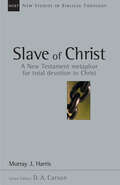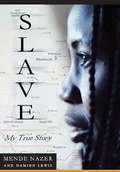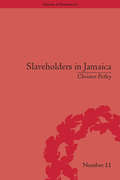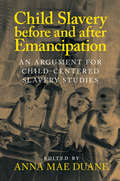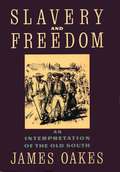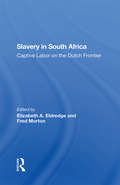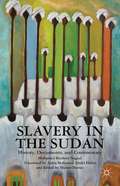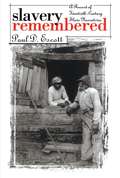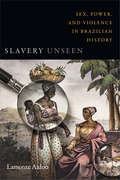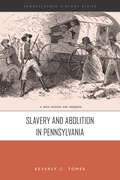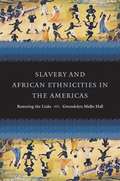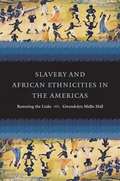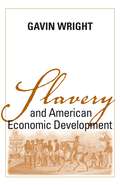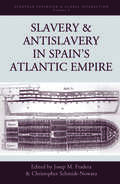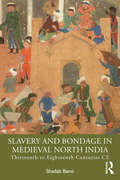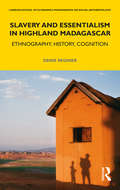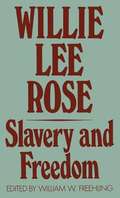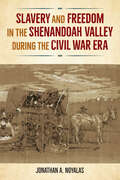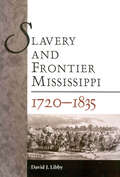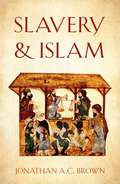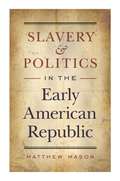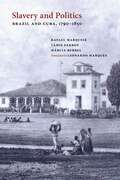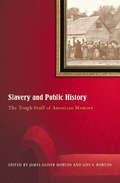- Table View
- List View
Slave of Christ: A New Testament Metaphor for Total Devotion to Christ (New Studies in Biblical Theology #Volume 8)
by Murray J. HarrisThe New Testament finds many ways to depict the relationship of Christians and their Lord. They are his disciples, sons, daughters and friends. But it is perhaps too little recognized that they are also his slaves. In this New Studies in Biblical Theology volume, Murray J. Harris sets out to uncover what it means to be a slave of Christ. He begins by assessing the nature of actual slavery in the Greco-Roman world and the New Testament's attitude towards it. Drawing insights from this, he goes on to unfold the metaphor of slavery to Christ. Among the topics discussed are slavery and spiritual freedom, lordship, ownership, and privilege. Slave of Christ is a model of good biblical theology, providing insights both for future study of the Bible and for practical application. Addressing key issues in biblical theology, the works comprising New Studies in Biblical Theology are creative attempts to help Christians better understand their Bibles. The NSBT series is edited by D. A. Carson, aiming to simultaneously instruct and to edify, to interact with current scholarship and to point the way ahead.
Slave: My True Story
by Damien Lewis Mende NazerMende Nazer lost her childhood at age twelve, when she was sold into slavery. It all began one horrific night in 1993, when Arab raiders swept through her Nuba village, murdering the adults and rounding up thirty-one children, including Mende. Mende was sold to a wealthy Arab family who lived in Sudan's capital city, Khartoum. So began her dark years of enslavement. Her Arab owners called her "Yebit," or "black slave." She called them "master." She was subjected to appalling physical, sexual, and mental abuse. She slept in a shed and ate the family leftovers like a dog. She had no rights, no freedom, and no life of her own. Normally, Mende's story never would have come to light. But seven years after she was seized and sold into slavery, she was sent to work for another master-a diplomat working in the United Kingdom. In London, she managed to make contact with other Sudanese, who took pity on her. In September 2000, she made a dramatic break for freedom. Slave is a story almost beyond belief. It depicts the strength and dignity of the Nuba tribe. It recounts the savage way in which the Nuba and their ancient culture are being destroyed by a secret modern-day trade in slaves. Most of all, it is a remarkable testimony to one young woman's unbreakable spirit and tremendous courage.
Slaveholders in Jamaica: Colonial Society and Culture during the Era of Abolition (Empires in Perspective #11)
by Christer PetleyExplores the social composition of the Jamaican slaveholding class during the era of the British campaign to end slavery, looking at their efforts to maintain control over local society and considering how their economic, cultural and military dependency on the colonial metropole meant that they were unable to avert the ending of British slavery.
Slaveries since Emancipation: Child Slavery Before and After Emancipation
by Duane Anna MaeIf we are to fully understand how slavery survived legal abolition, we must grapple with the work that abolition has left undone, and dismantle the structures that abolition has left in place. Child Slavery before and after Emancipation seeks to enable a vital conversation between historical and modern slavery studies - two fields that have traditionally run along parallel tracks rather than in relation to one another. In this collection, Anna Mae Duane and her interdisciplinary group of contributors seek to build historical and contemporary bridges between race-based chattel slavery and other forms of forced child labor, offering a series of case studies that illuminate the varied roles of enslaved children. Duane provides a provocative, historically grounded set of inquiries that suggest how attending to child slaves can help to better define both slavery and freedom.
Slavery And Freedom: An Interpretation of the Old South
by James OakesThis pathbreaking interpretation of the slaveholding South begins with the insight that slavery and freedom were not mutually exclusive but were intertwined in every dimension of life in the South. James Oakes traces the implications of this insight for relations between masters and slaves, slaveholders and non-slaveholders, and for the rise of a racist ideology.
Slavery In South Africa: Captive Labor On The Dutch Frontier
by Elizabeth Eldredge Fred MortonSouth African slavery differs from slavery practiced in other frontier zones of European settlement in that the settlers enslaved indigenes as a supplement to and eventually as a replacement for imported slave labor. On the expanding frontier, Dutch-speaking farmers increasingly met their labor needs by conducting slave raids, arming African slave
Slavery In The Sudan
by Mohamed Ibrahim NugudThis groundbreaking study offers a rare window into the history of slavery in the Sudan, with particular attention to the relationships between slaves and masters. Thoroughly documented, it provides valuable context to current issues of global concern and combats persistent myths about African slavery.
Slavery Remembered
by Paul D. EscottSlavery Remembered is the first major attempt to analyze the slave narratives gathered as part of the Federal Writers' Project. Paul Escott's sensitive examination of each of the nearly 2,400 narratives and his quantitative analysis of the narratives as a whole eloquently present the differing beliefs and experiences of masters and slaves. The book describes slave attitudes and actions; slave-master relationships; the conditions of slave life, including diet, physical treatment, working conditions, housing, forms of resistance, and black overseers; slave cultural institutions; status distinctions among slaves; experiences during the Civil War and Reconstruction; and the subsequent life histories of the former slaves.An important contribution to the study of American slavery, Slavery Remembered is an ideal classroom text for American history surveys as well as more specialized courses.Slavery Remembered is an important contribution to the study of American slavery and, because of its brevity and clarity, an ideal classroom text for American history surveys as well as more specialized courses.-->
Slavery Unseen: Sex, Power, and Violence in Brazilian History (Latin America Otherwise)
by Lamonte AidooIn Slavery Unseen, Lamonte Aidoo upends the narrative of Brazil as a racial democracy, showing how the myth of racial democracy elides the history of sexual violence, patriarchal terror, and exploitation of slaves. <P><P>Drawing on sources ranging from inquisition trial documents to travel accounts and literature, Aidoo demonstrates how interracial and same-sex sexual violence operated as a key mechanism of the production and perpetuation of slavery as well as racial and gender inequality. <P>The myth of racial democracy, Aidoo contends, does not stem from or reflect racial progress; rather, it is an antiblack apparatus that upholds and protects the heteronormative white patriarchy throughout Brazil's past and on into the present.
Slavery and Abolition in Pennsylvania (Pennsylvania History)
by Beverly C. TomekIn her concise history Slavery and Abolition in Pennsylvania, Beverly Tomek corrects the long-held notion that slavery in the North was “not so bad” as, or somehow “more humane” than, in the South due to the presence of abolitionists. While the Quaker presence focused on moral and practical opposition to bondage, slavery was ubiquitous. Nevertheless, Pennsylvania was the first state to pass an abolition law in the United States. Slavery and Abolition in Pennsylvania traces this movement from its beginning to the years immediately following the American Civil War. Discussions of the complexities of the state’s antislavery movement illustrate how different groups of Pennsylvanians followed different paths in an effort to achieve their goal. Tomek also examines the backlash abolitionists and Black Americans faced. In addition, she considers the civil rights movement from the period of state reconstruction through the national reconstruction that occurred after the Civil War. While the past few decades have shed light on enslavement and slavery in the South, much of the story of northern slavery remains hidden. Slavery and Abolition in Pennsylvania tells the full and inclusive story of this history, bringing the realities of slavery, abolition, and Pennsylvania's attempt to reconstruct its post-emancipation society.
Slavery and African Ethnicities in the Americas
by Gwendolyn Midlo HallEnslaved peoples were brought to the Americas from many places in Africa, but a large majority came from relatively few ethnic groups. Drawing on a wide range of materials in four languages as well as on her lifetime study of slave groups in the New World, Gwendolyn Midlo Hall explores the persistence of African ethnic identities among the enslaved over four hundred years of the Atlantic slave trade. Hall traces the linguistic, economic, and cultural ties shared by large numbers of enslaved Africans, showing that despite the fragmentation of the diaspora many ethnic groups retained enough cohesion to communicate and to transmit elements of their shared culture. Hall concludes that recognition of the survival and persistence of African ethnic identities can fundamentally reshape how people think about the emergence of identities among enslaved Africans and their descendants in the Americas, about the ways shared identity gave rise to resistance movements, and about the elements of common African ethnic traditions that influenced regional creole cultures throughout the Americas.Enslaved peoples were brought to the Americas from many places in Africa, but a large majority came from relatively few ethnic groups. Gwendolyn Midlo Hall traces the linguistic, economic, and cultural ties shared by large numbers of enslaved Africans, showing that despite the fragmentation of the diaspora many ethnic groups retained enough cohesion to communicate and to transmit elements of their shared culture. Hall concludes that recognizing the persistence of African ethnic identities can reshape how people think about the emergence of identities among enslaved Africans and their descendants in the Americas, about the ways shared identity gave rise to resistance movements, and about the elements of common African ethnic traditions that influenced regional creole cultures throughout the Americas.-->
Slavery and African Ethnicities in the Americas: Restoring the Links
by Gwendolyn Midlo HallDrawing on a wide range of materials in four languages as well as on a lifetime of study of slave groups in the New World, Gwendolyn Midlo Hall explores the persistence of African ethnic identities among the enslaved over four hundred years of the Atlantic slave trade. Hall traces the linguistic, economic, and cultural ties shared by large numbers of enslaved Africans, showing that despite the fragmentation of the diaspora, many ethnic groups retained enough cohesion to communicate and to transmit elements of their shared culture.
Slavery and American Economic Development: A Novel (Walter Lynwood Fleming Lectures in Southern History)
by Gavin Wright"Slavery and American Economic Development is a small book with a big interpretative punch. It is one of those rare books about a familiar subject that manages to seem fresh and new." -- Charles B. Dew, Journal of Interdisciplinary History "A stunning reinterpretation of southern economic history and what is perhaps the most important book in the field since Time on the Cross.... I frequently found myself forced to rethink long-held positions." -- Russell R. Menard, Civil War History Through an analysis of slavery as an economic institution, Gavin Wright presents an innovative look at the economic divergence between North and South in the antebellum era. He draws a distinction between slavery as a form of work organization -- the aspect that has dominated historical debates -- and slavery as a set of property rights. Slave-based commerce remained central to the eighteenth-century rise of the Atlantic economy, not because slave plantations were superior as a method of organizing production, but because slaves could be put to work on sugar plantations that could not have attracted free labor on economically viable terms.Gavin Wright is William Robertson Coe Professor in American Economic History at Stanford University and the author of The Political Economy of the Cotton South and Old South, New South: Revolutions in the Southern Economy since the Civil War, winner of the Frank L. and Harriet C. Owsley Award of the Southern Historical Association. He has served as president of the Economic History Association and the Agricultural History Society.
Slavery and Antislavery in Spain's Atlantic Empire
by Christopher Schmidt-Nowara† Josep M. FraderaAfrican slavery was pervasive in Spain's Atlantic empire yet remained in the margins of the imperial economy until the end of the eighteenth century when the plantation revolution in the Caribbean colonies put the slave traffic and the plantation at the center of colonial exploitation and conflict. The international group of scholars brought together in this volume explain Spain's role as a colonial pioneer in the Atlantic world and its latecomer status as a slave-trading, plantation-based empire. These contributors map the broad contours and transformations of slave-trafficking, the plantation, and antislavery in the Hispanic Atlantic while also delving into specific topics that include: the institutional and economic foundations of colonial slavery; the law and religion; the influences of the Haitian Revolution and British abolitionism; antislavery and proslavery movements in Spain; race and citizenship; and the business of the illegal slave trade.
Slavery and Bondage in Medieval North India: Thirteenth to Eighteenth Centuries CE
by Shadab BanoThis book examines slavery in India from the Turkish conquest of North India to the centuries of Mughal rule. It focuses on the northern Islamic regimes’ treatment of slavery but not limited or determined by the actions and demands of the ruling class alone. Societies normalized the practices, and the norms were socially constituted, which included slaves’ acceptance, resistance, and use of agency in the process. It shows how the transformations on the ground made the social-economic and ethical environment of slavery no longer the same over the centuries and the expansion or contraction of slavery corresponded to the structural changes and ethical developments specific to the Indian milieu.The volume will be of great interest to scholars and researchers of South Asian studies, history and slavery.
Slavery and Emancipation in Islamic East Africa
by Elisabeth McmahonExamining the process of abolition on the island of Pemba off the East African coast in the late nineteenth and early twentieth centuries, this book demonstrates the links between emancipation and the redefinition of honour among all classes of people on the island. By examining the social vulnerability of ex-slaves and the former slave-owning elite caused by the abolition order of 1897, this study argues that moments of resistance on Pemba reflected an effort to mitigate vulnerability rather than resist the hegemonic power of elites or the colonial state. As the meaning of the Swahili word heshima shifted from honour to respectability, individuals' reputations came under scrutiny and the Islamic kadhi and colonial courts became an integral location for interrogating reputations in the community. This study illustrates the ways in which former slaves used piety, reputation, gossip, education, kinship and witchcraft to negotiate the gap between emancipation and local notions of belonging.
Slavery and Essentialism in Highland Madagascar: Ethnography, History, Cognition (LSE Monographs on Social Anthropology)
by Denis RegnierThis book explores the prejudice against slave descendants in highland Madagascar and its persistence more than a century after the official abolition of slavery. ‘Unclean people’ is a widespread expression in the southern highlands of Madagascar, and refers to people of alleged slave descent who are discriminated against on a daily basis and in a variety of ways. Denis Regnier shows that prejudice is rooted in a strong case of psychological essentialism: free descendants think that ‘slaves’ have a ‘dirty’ essence that is impossible to cleanse. Regnier’s field experiments question the widely accepted idea that the social stigma against slavery is a legacy of pre-colonial society. He argues, to the contrary, that the essentialist construal of ‘slaves’ is the outcome of the historical process triggered by the colonial abolition of slavery: whereas in pre-abolition times slaves could be cleansed through ritual means, the abolition of slavery meant that slaves were transformed only superficially into free persons, while their inner essence remained unchanged and became progressively constructed as ‘forever unchangeable’. Based on detailed fieldwork, this volume will be of interest to scholars of anthropology, African studies, development studies, cultural psychology, and those looking at the legacy of slavery.
Slavery and Forced Migration in the Antebellum South
by Damian Alan PargasAmerican slavery in the antebellum period was characterized by a massive wave of forced migration as millions of slaves were moved across state lines to the expanding southwest, scattered locally, and sold or hired out in towns and cities across the South. This book sheds new light on domestic forced migration by examining the experiences of American-born slave migrants from a comparative perspective. Juxtaposing and contrasting the experiences of long-distance, local, and urban slave migrants, it analyzes how different migrant groups anticipated, reacted to, and experienced forced removal, as well as how they adapted to their new homes.
Slavery and Freedom in the Shenandoah Valley during the Civil War Era (Southern Dissent)
by Jonathan NoyalasThe African American experience in Virginia's Shenandoah Valley from the antebellum period through ReconstructionThis book examines the complexities of life for African Americans in Virginia’s Shenandoah Valley from the antebellum period through Reconstruction. Although the Valley was a site of fierce conflicts during the Civil War and its military activity has been extensively studied, scholars have largely ignored the Black experience in the region until now. Correcting previous assumptions that slavery was not important to the Valley, and that enslaved people were treated better there than in other parts of the South, Jonathan Noyalas demonstrates the strong hold of slavery in the region. He explains that during the war, enslaved and free African Americans navigated a borderland that changed hands frequently—where it was possible to be in Union territory one day, Confederate territory the next, and no-man’s land another. He shows that the region’s enslaved population resisted slavery and supported the Union war effort by serving as scouts, spies, and laborers, or by fleeing to enlist in regiments of the United States Colored Troops. Noyalas draws on untapped primary resources, including thousands of records from the Freedmen’s Bureau and contemporary newspapers, to continue the story and reveal the challenges African Americans faced from former Confederates after the war. He traces their actions, which were shaped uniquely by the volatility of the struggle in this region, to ensure that the war’s emancipationist legacy would survive. A volume in the series Southern Dissent, edited by Stanley Harrold and Randall M. Miller
Slavery and Frontier Mississippi, 1720-1835
by David J. LibbyIn the popular imagination the picture of slavery, frozen in time, is one of huge cotton plantations and opulent mansions. However, in over a hundred years of history detailed in this book, the hard reality of slavery in Mississippi's antebellum world is strikingly different from the one of popular myth. It shows that Mississippi's past was never frozen, but always fluid. It shows too that slavery took a number of shapes before its form in the late antebellum mold became crystalized for popular culture. The colonial French introduced African slaves into this borderlands region situated on the periphery of French, Spanish, and English empires. In this frontier, planter society made unsuccessful attempts to produce tobacco, lumber, and indigo. Slavery outlasted each failed harvest. Through each era, plantation culture rode the back of a system far removed from the romantic stereotype. Almost simultaneously as Mississippi became a United States territory in the 1790s, cotton became the cash crop. The booming King Cotton economy changed Mississippi and adapted the slave system that was its foundation. Some Mississippi slaves resisted this grim oppression and rebelled by flight, work slowdowns, arson, and conspiracies. In 1835 a slave conspiracy in Madison County provoked such draconian response among local slave holders that planters throughout the state redoubled the iron locks on the system. Race relations in the state remained radicalized for many generations to follow. Beginning with the arrival of the first African slaves in the colony and extending over 115 years, this book is the first such history since Charles Sydnor's Slavery in Mississippi (1933).
Slavery and Islam
by Jonathan A.C. BrownWhat happens when authorities you venerate condone something you know is wrong? Every major religion and philosophy once condoned or approved of slavery, but in modern times nothing is seen as more evil. Americans confront this crisis of authority when they erect statues of Founding Fathers who slept with their slaves. And Muslims faced it when ISIS revived sex-slavery, justifying it with verses from the Quran and the practice of Muhammad. Exploring the moral and ultimately theological problem of slavery, Jonathan A.C. Brown traces how the Christian, Jewish and Islamic traditions have tried to reconcile modern moral certainties with the infallibility of God&’s message. He lays out how Islam viewed slavery in theory, and the reality of how it was practiced across Islamic civilization. Finally, Brown carefully examines arguments put forward by Muslims for the abolition of slavery. CONTENTS Preface Acknowledgments Notes on transliteration, dates and citationIntroduction: Can We Talk About Slavery? What I Argue in this Book Apology for Slavery? Power and the Study of Slavery Blackness, Whiteness and Slavery 1. Does &‘Slavery&’ Exist? The Problem of Definition The Main Argument Definition: A Creative Process Definition to Discourse: A Political Process Defining \ˈslā-v(ə-)rē\: We Know It When We See It Defining Slavery as Status or a Condition Slavery as Unfreedom Slavery as Human Property Patterson & Natal Alienation Slavery as Distinction: The Lowest Rung & Marginality Slavery as Coercion & Exploitation under the Threat of Violence The Problem with Modern-Day Slavery Slavery & Islam – A Very Political Question Conclusion: Of Course, Slavery Exists The Proper Terms for Speaking about &‘Slavery&’ 2. Slavery in the Shariah What Islam Says about Slavery – Ideals and Reality Slavery in the Quran & Sunna Inheriting the Near East – Roman, Jewish and Near Eastern Laws versus Islam Islam&’s Reform of Slavery Basic Principles of Riqq in the Shariah The Ambiguities of Slavery in the Shariah Riqq & Rights in the Shariah Religious Practice Freedom of Movement Social and Political Roles Marriage and Family Life Right to Property Rights to Life and Physical Protection Summary: Law and Ethics 3. Slavery in Islamic Civilization What is Islamic Civilization? Is there &‘Islamic Slavery&’? The Shariah & Islamic Slavery Muslims Enslaving Muslims The Classic Slavery Zone Consuming People & &‘Ascending Miscegenation&’ Slave Populations Routes of the Muslim Slave Trade Blackness and Slavery in Islamic Civilization The Roles and Experiences of Slaves in Islamic Civilization The Slave as Uprooted Person and Commodity The Slave as Domestic Labor . . . Even Trusted Member of a Household Slave as Sexual Partner Slave as Saint, Scholar or Poet Slave as Elite Administrator & Courtesan Slave as Soldier – When Soldiers often Ruled Slave as Rebel 4. The Slavery Conundrum No Squaring the Circle: The American/Islamic Slavery Conundrum Slavery is Evil The Intrinsic Wrongs of Slavery Religions and Slavery Minimizing the Unminimizable or Historicizing the Unhistoricizable Slavery is Slavery: The Problem of Labeling &‘Slavery&’ with One Moral Judgment The Moral Wrongness of Slavery as Unfreedom The Moral Wrongness of Slavery as Owning Human Property<
Slavery and Politics in the Early American Republic
by Matthew MasonGiving close consideration to previously neglected debates, Matthew Mason challenges the common contention that slavery held little political significance in America until the Missouri Crisis of 1819. Mason demonstrates that slavery and politics were enmeshed in the creation of the nation, and in fact there was never a time between the Revolution and the Civil War in which slavery went uncontested. The American Revolution set in motion the split between slave states and free states, but Mason explains that the divide took on greater importance in the early nineteenth century. He examines the partisan and geopolitical uses of slavery, the conflicts between free states and their slaveholding neighbors, and the political impact of African Americans across the country.Offering a full picture of the politics of slavery in the crucial years of the early republic, Mason demonstrates that partisans and patriots, slave and free--and not just abolitionists and advocates of slavery--should be considered important players in the politics of slavery in the United States.Giving close consideration to previously neglected debates, Matthew Mason challenges the common contention that slavery held little political significance in America until the Missouri Crisis of 1819. Mason demonstrates that slavery and politics were enmeshed in the creation of the nation, and that in fact there was never a time between the Revolution and the Civil War in which slavery went uncontested. Offering a full picture of the politics of slavery in the crucial years of the early republic, Mason demonstrates that partisans and patriots, slave and free--and not just abolitionists and advocates of slavery--should be considered important players in the politics of slavery in the United States.-->
Slavery and Politics: Brazil and Cuba, 1790-1850
by Rafael Marquese Tâmis Parron Berbel MárciaThe politics of slavery and slave trade in nineteenth-century Cuba and Brazil is the subject of this acclaimed study, first published in Brazil in 2010 and now available for the first time in English. Cubans and Brazilians were geographically separate from each other, but they faced common global challenges that unified the way they re-created their slave systems between 1790 and 1850 on a basis completely departed from centuries-old colonial slavery. Here the authors examine the early arguments and strategies in favor of slavery and the slave trade and show how they were affected by the expansion of the global market for tropical goods, the American Revolution, the Haitian Revolution, the collapse of Iberian monarchies, British abolitionism, and the international pressure opposing the transatlantic slave trade. This comprehensive survey contributes to the comparative history of slavery, placing the subject in a global context rather than simply comparing the two societies as isolated units.
Slavery and Public History: The Tough Stuff of American Memory
by Ira Berlin Gary B. Nash David W. Blight&“A fascinating collection of essays&” by eminent historians exploring how we teach, remember, and confront the history and legacy of American slavery (Booklist Online). In recent years, the culture wars have called into question the way America&’s history of slavery is depicted in books, films, television programs, historical sites, and museums. In the first attempt to examine the historiography of slavery, this unique collection of essays looks at recent controversies that have played out in the public arena, with contributions by such noted historians as Ira Berlin, David W. Blight, and Gary B. Nash. From the cancellation of the Library of Congress&’s &“Back of the Big House&” slavery exhibit at the request of the institution&’s African American employees, who found the visual images of slavery too distressing, to the public reaction to DNA findings confirming Thomas Jefferson&’s relationship with his slave Sally Hemings, Slavery and Public History takes on contemporary reactions to the fundamental contradiction of American history—the existence of slavery in a country dedicated to freedom—and offers a bracing analysis of how Americans choose to remember the past, and how those choices influence our politics and culture. &“Americans seem perpetually surprised by slavery—its extent (North as well as South), its span (over half of our four centuries of Anglo settlement), and its continuing influence. The wide-ranging yet connected essays in [this book] will help us all to remember and understand.&” —James W. Loewen, author of Sundown Towns
